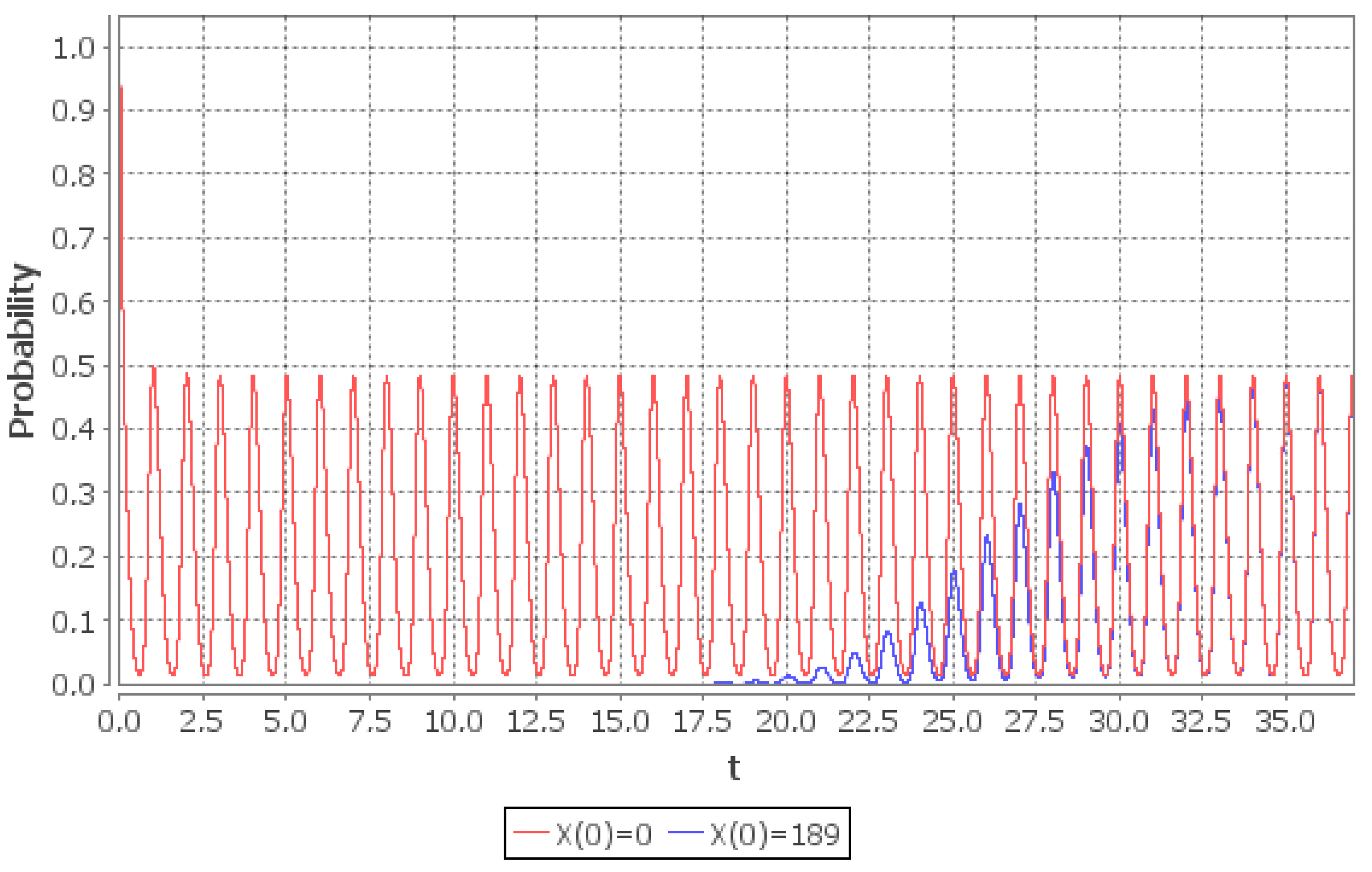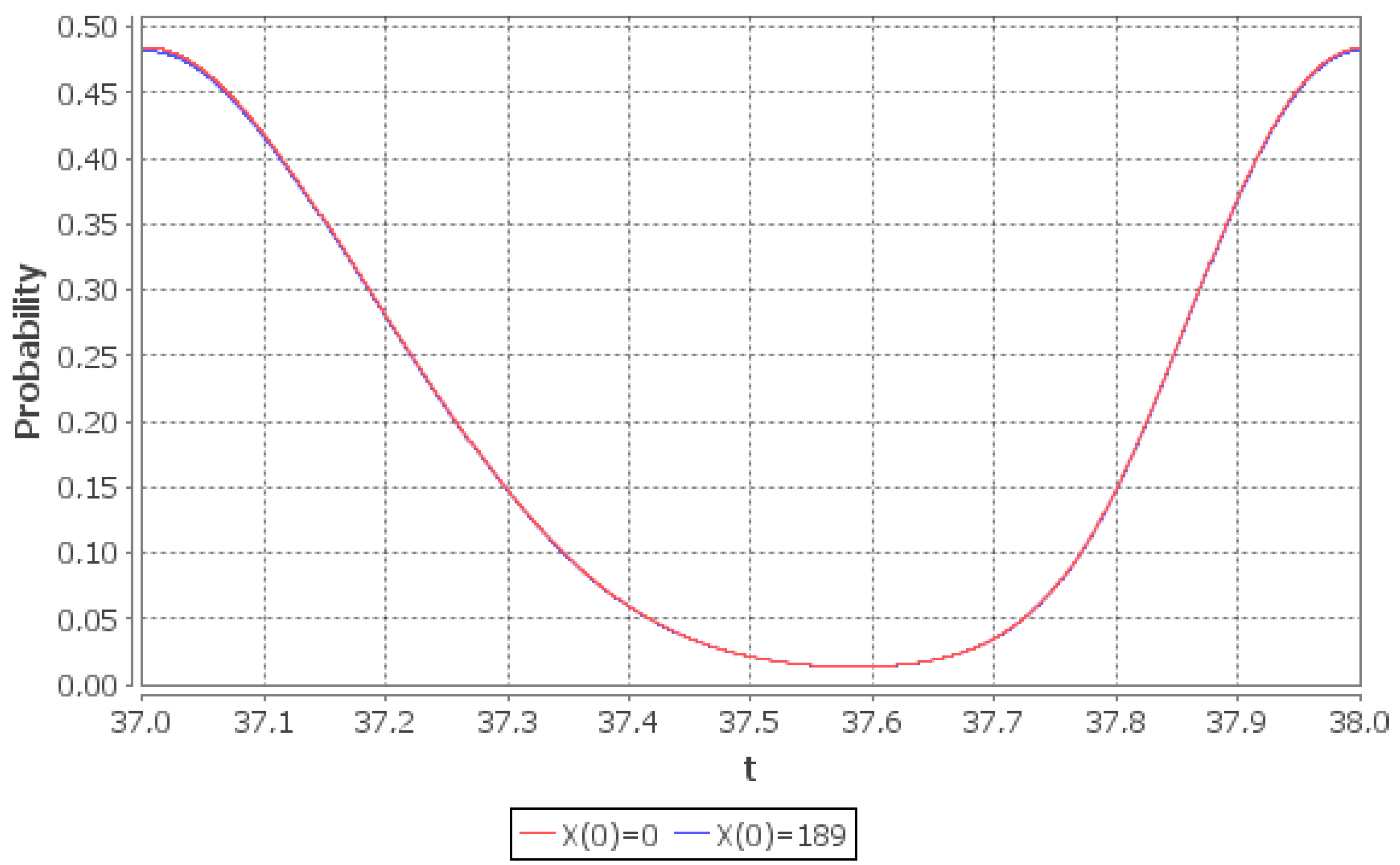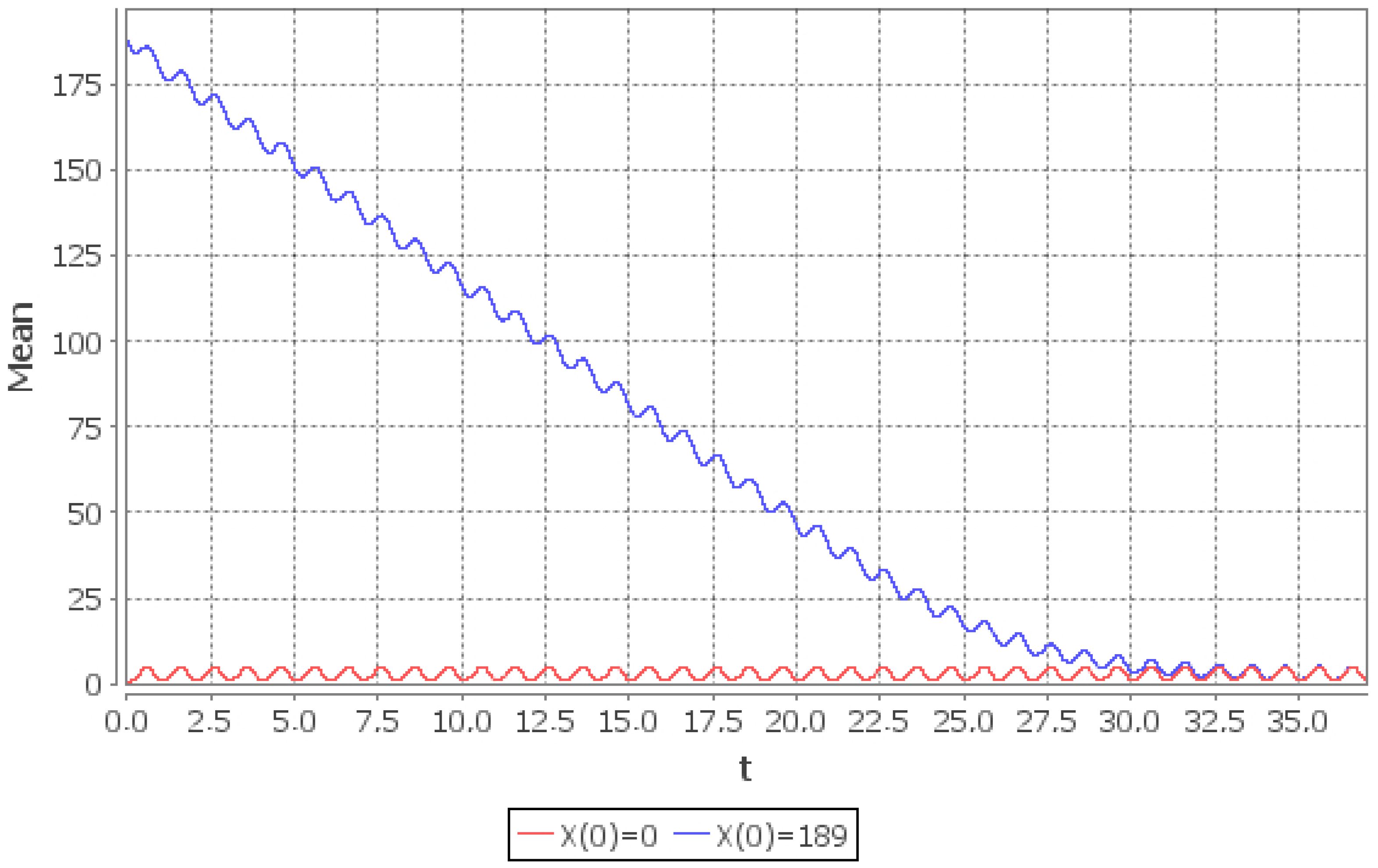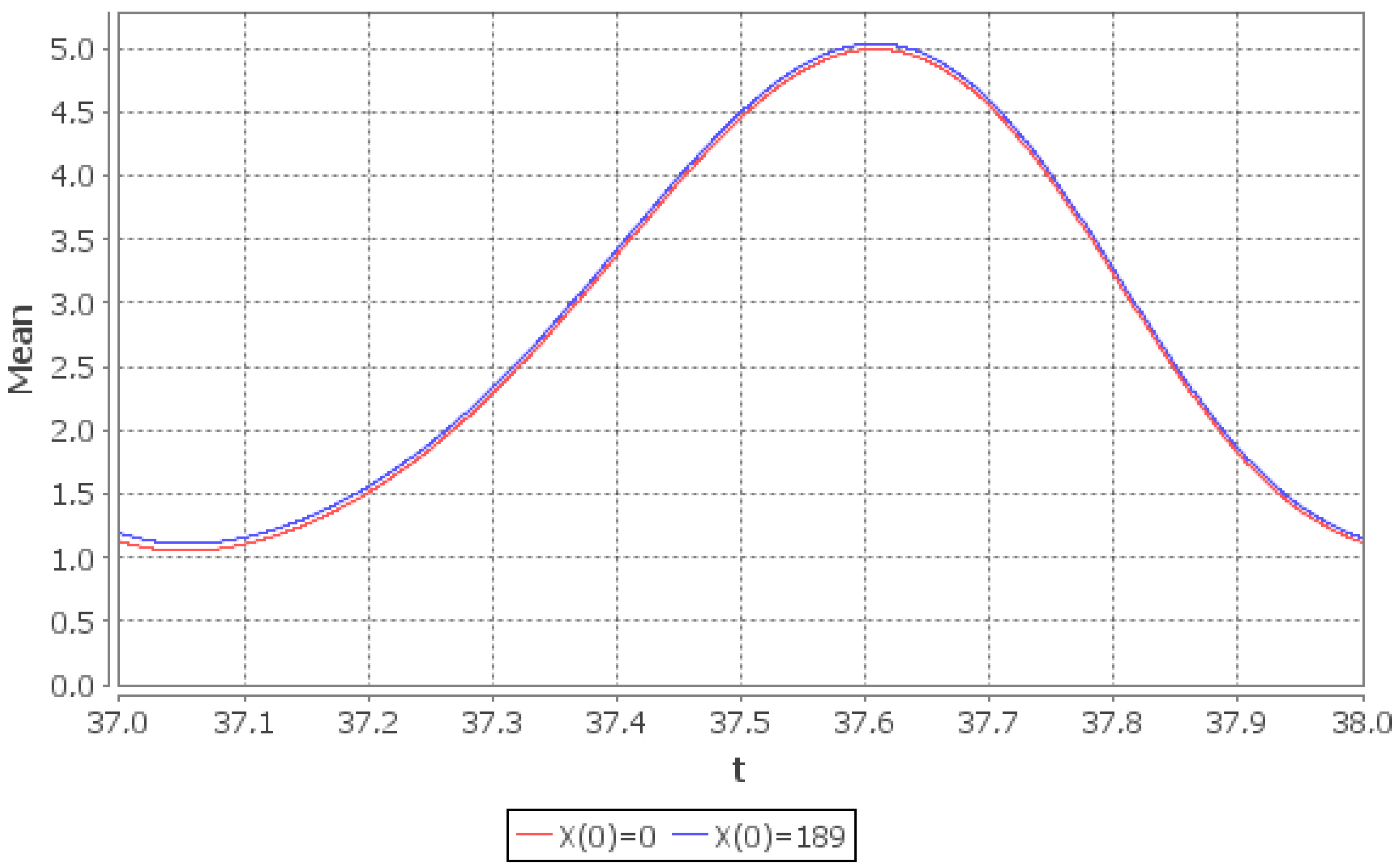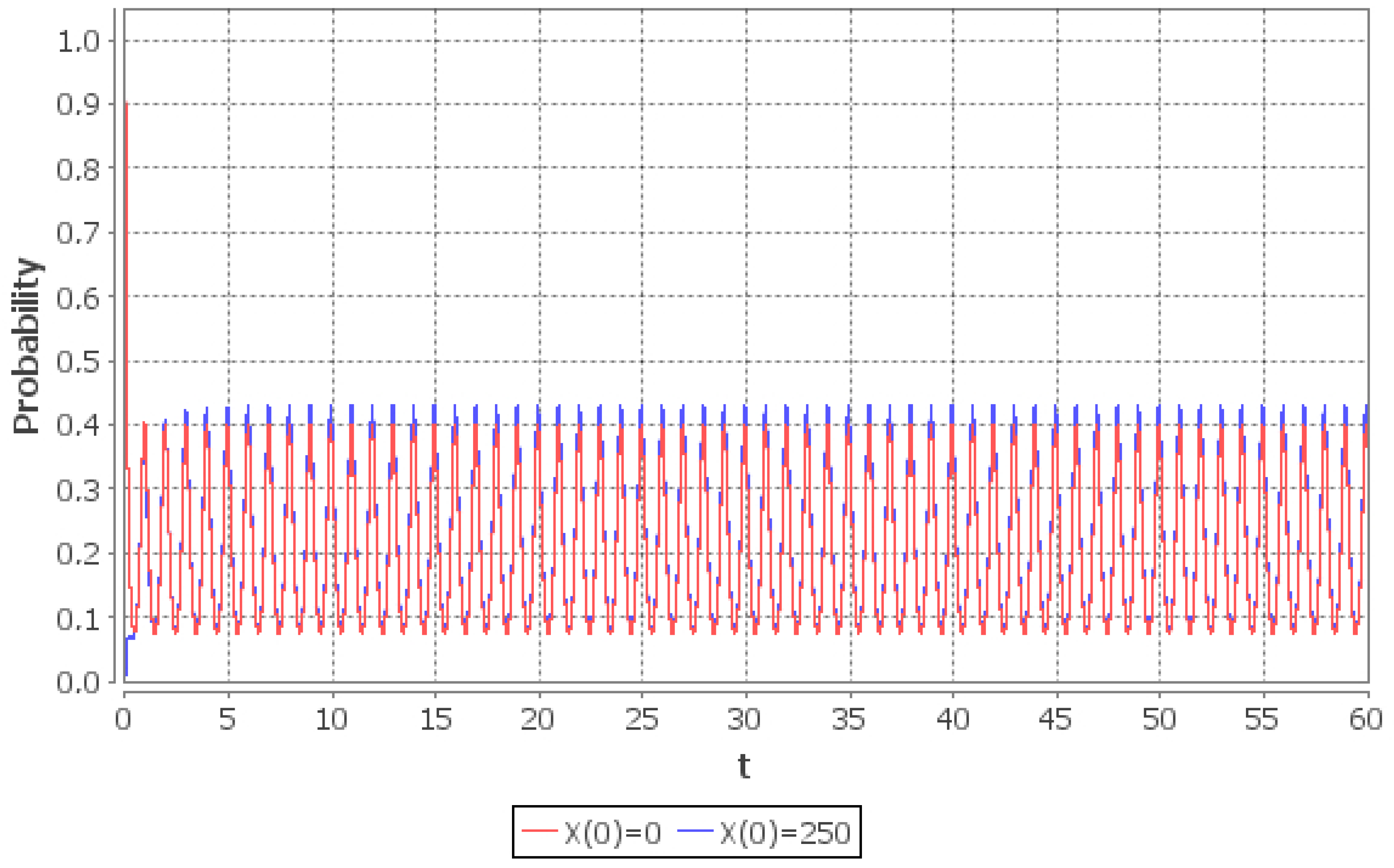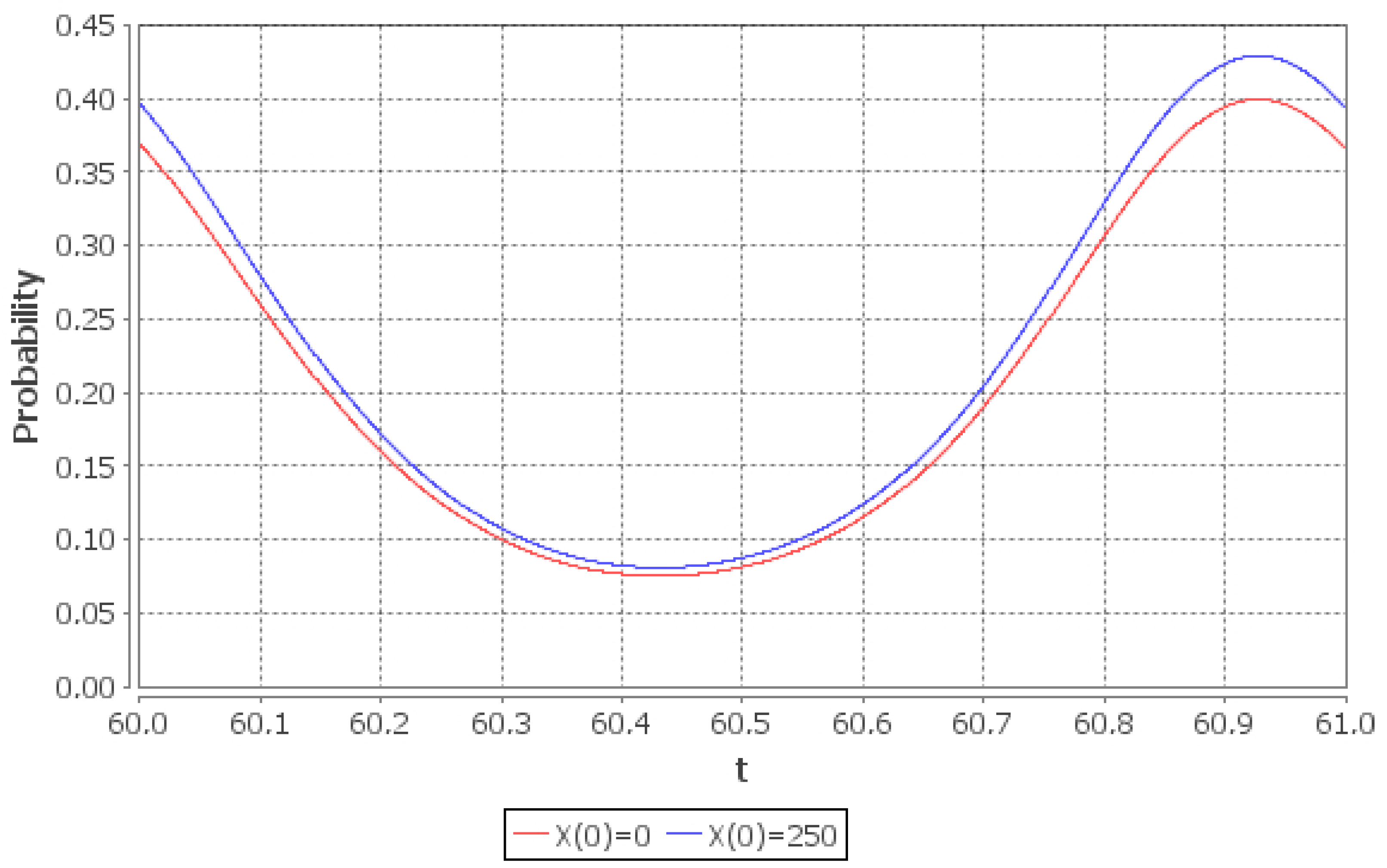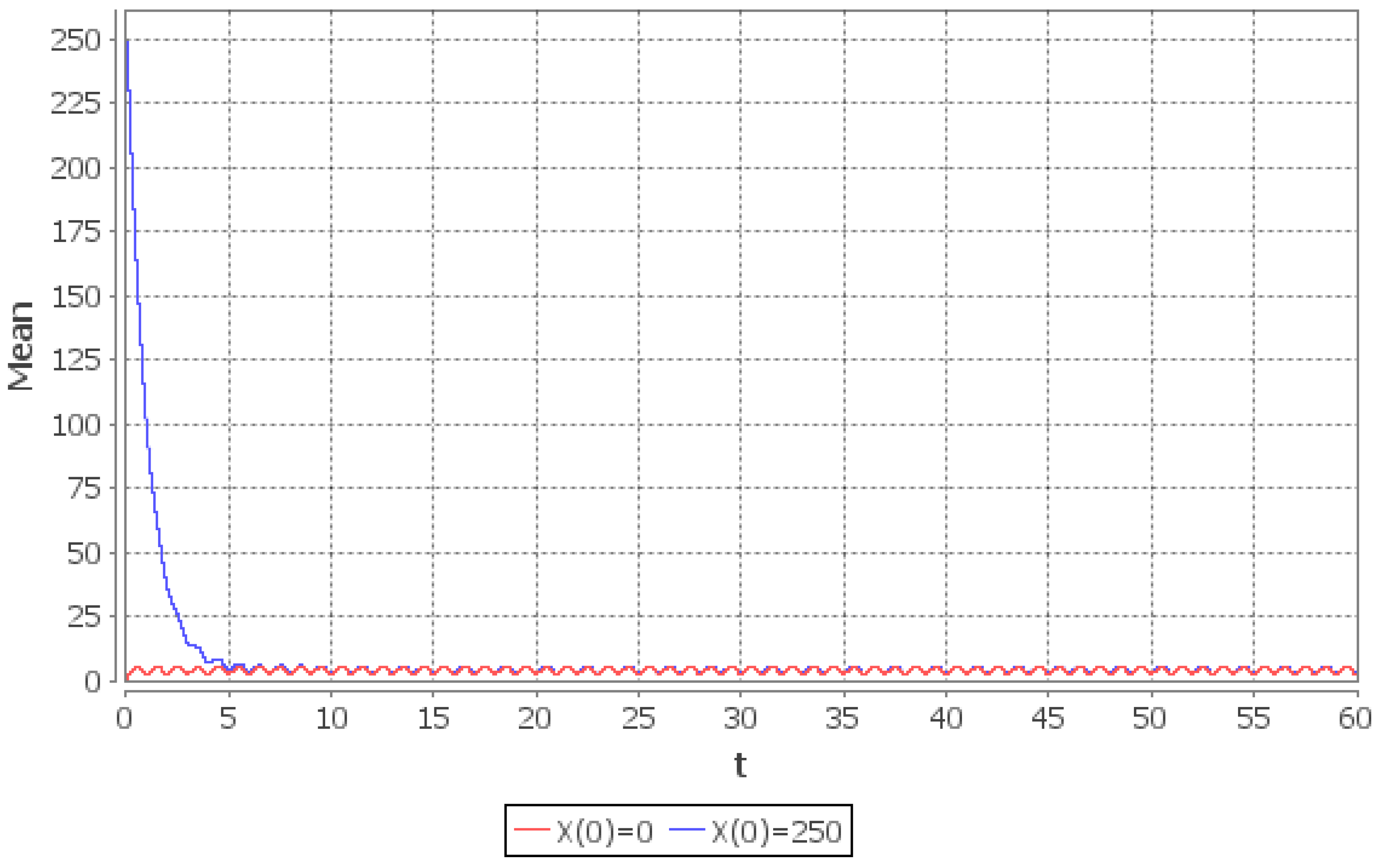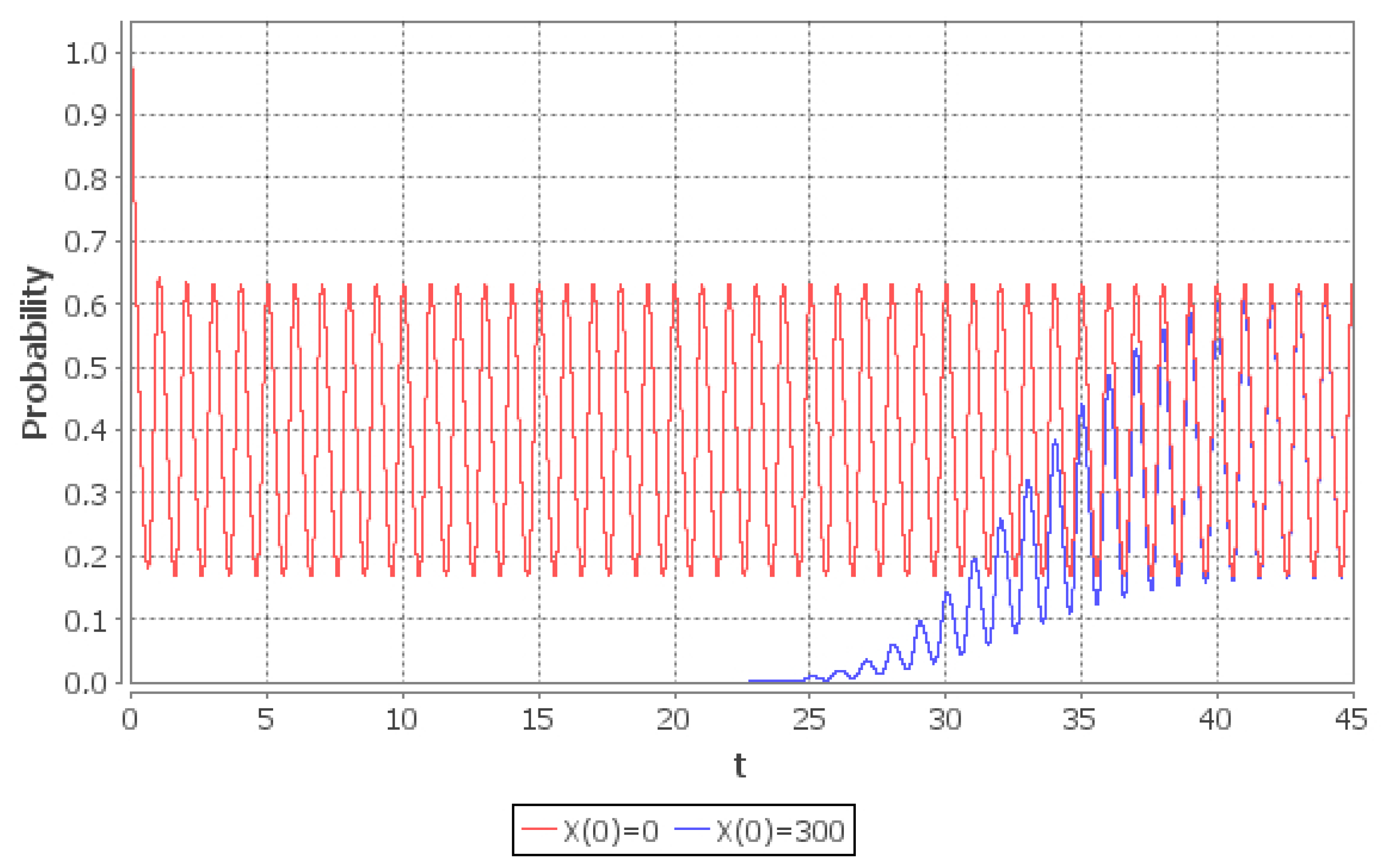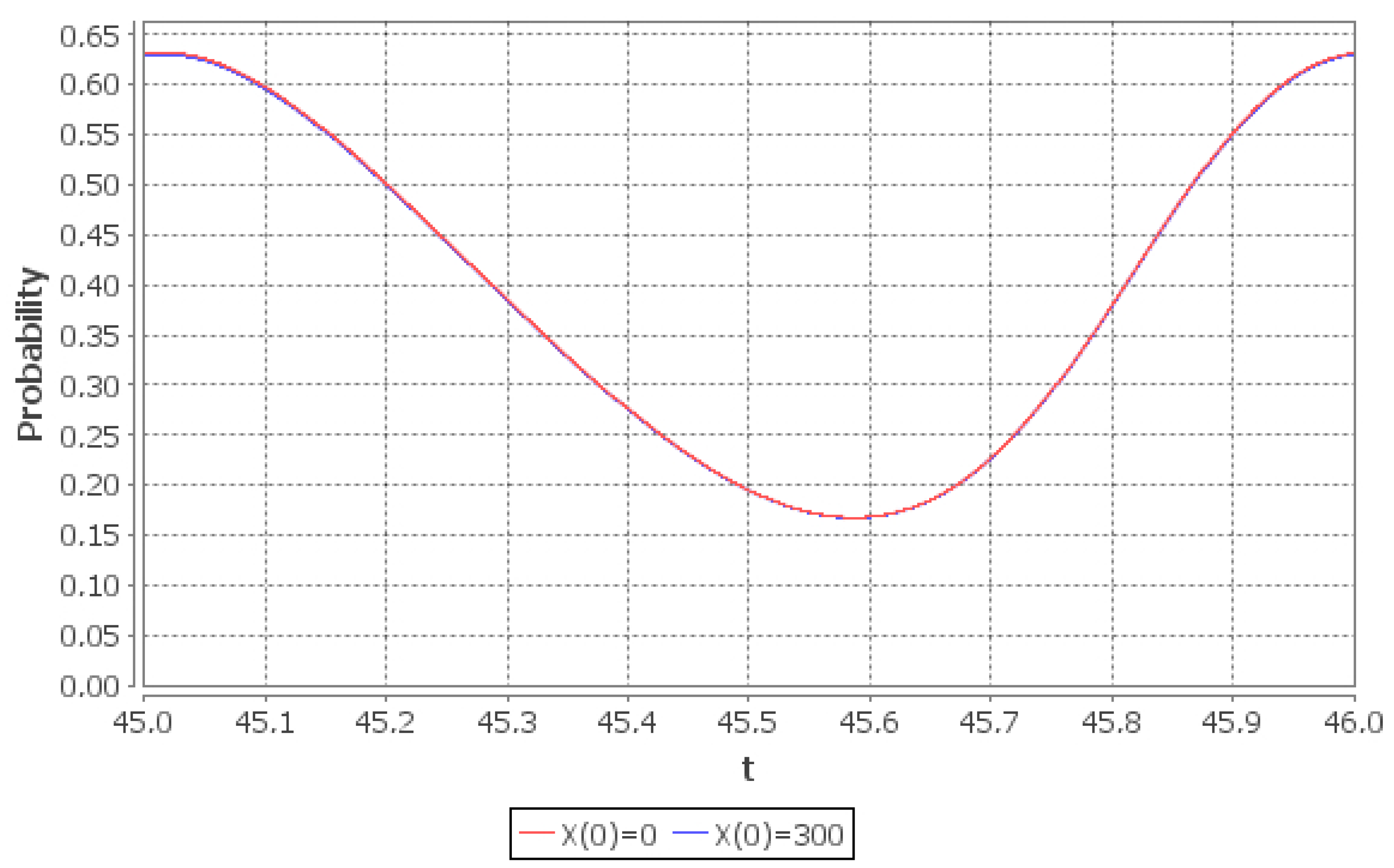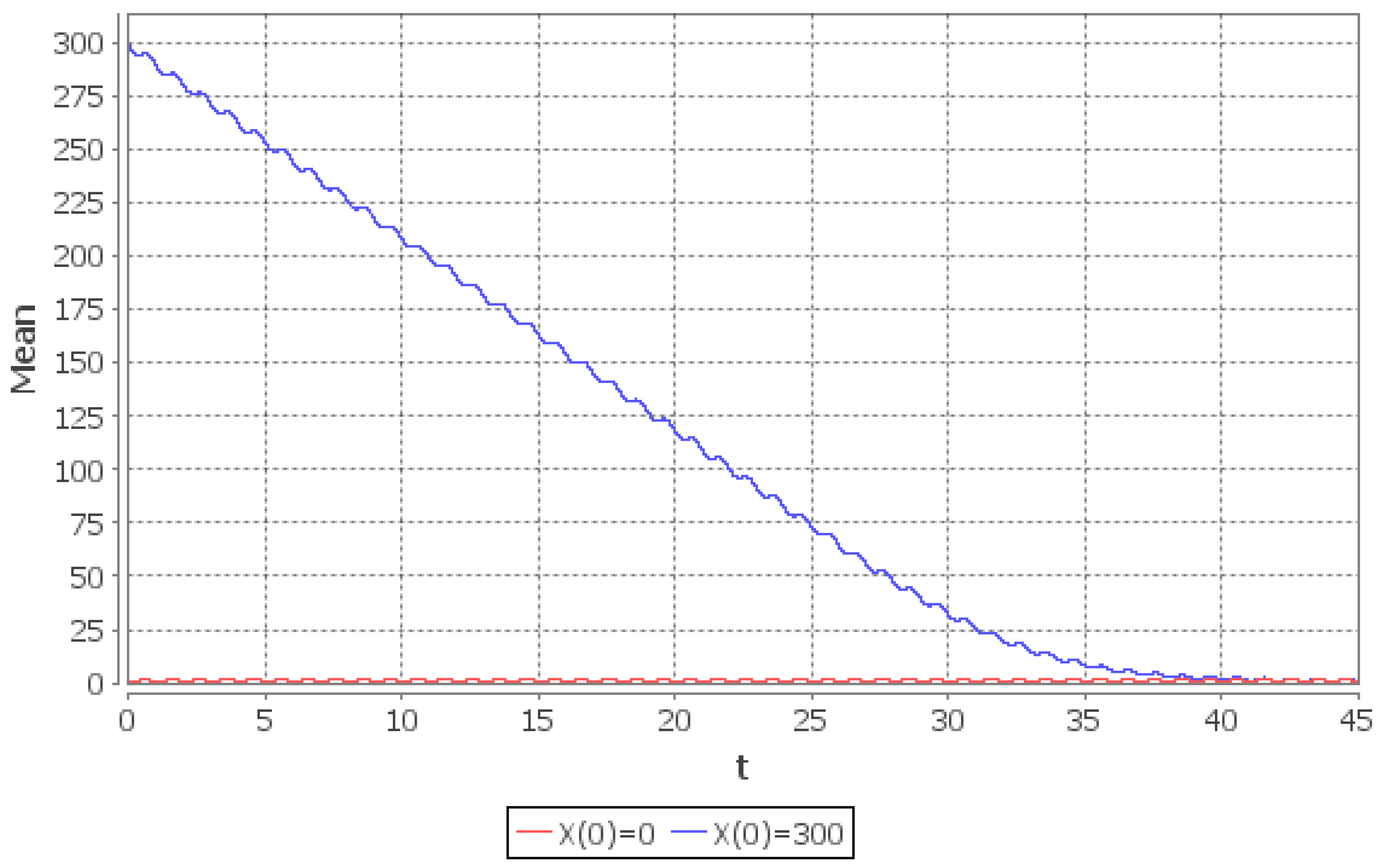1. Introduction
The topic of this paper concerns the analysis of (one-dimensional) inhomogeneous
continuous-time Markov chains (CTMC) with discrete state space. The inhomogeneity property implies that (some or all) transition intensities are non-random functions of time and (may or may not) depend on the state of the chain. For such mathematical models many operations research applications are known (see, for example, [
1,
2,
3,
4] and [Section 5] in [
5]), but the motivation of this paper is queueing. Thus all the examples considered in this paper are devoted to time varying queues. Substantial literature on the problem exists in which various aspects (like existence of processes, numerical algorithms, asymptotics, approximations and others) are analyzed. The attempt to give a systematic classification of the available approaches (based on the papers published up to 2016) is made in [
5]; up-to-date point of view is given in [Sections 1 and 1.2] of [
4] (see also [
6]).
The specific question, being the topic of this paper, is the computation of the long-run (see, for example, in [Introduction] of [
7]), (limiting) time-dependent performance characteristics of a CTMC with time varying intensities. This question can be considered from different point of views: computation time, accuracy, complexity, storage use etc. As a result, various solution techniques have been developed, but none of them is the ubiquitous tool. One of the ways to improve the efficiency of a solution technique is to supply it with a method for the limiting regime detection, (or, in other words, a method providing ergodicity bounds): once the limiting regime is reached, there is no need to continue the computation indefinitely. The main contribution of this paper is the review of one such method (see
Section 2) and presentation of its applicability in two new use-cases, not considered before in the literature (see
Section 4 and
Section 5). It is worth noting that methods, which provide ergodicity bounds, can be also helpful, whenever a truncation of the countable state space of the chain is required. The method presented in
Section 2, whenever applicable, is helpful in this aspect as well (see also [
8,
9]).
The end of this section is devoted to the review (by no means exhaustive) of the popular solution techniques for the analysis of Markov chains in time varying queueing models. The attention is drawn to the ability of a technique to yield limiting time-dependent performance characteristics of a Markov chain with time varying intensities. For each technique mentioned, (computer simulation methods and numerical transform inversion algorithms are not discussed here), it is highlighted if any benefit can be gained when the technique is used along with a method providing ergodicity bounds.
In many applied settings the performance analysis is based on the procedure known as point-wise stationary approximation [
10] and its ramifications. According to it the time-dependent probability vector
at time
t is approximated by the steady-state probability vector
by solving
and
, where
is the time-dependent intensity matrix (throughout the paper the vectors denoted by bold letters are regarded as column vectors,
denotes the
kth unit basis vector,
—row vector of 1’s with
denoting the matrix transpose). In its initial version, the approximation breaks down if the instantaneous system’s load is allowed to exceed 1. In general its quality depends on the values of the transition rates, and for some models (like time-dependent birth-and-death processes) the approach is proved to be correct asymptotically in the limit (as transition intensities increase). Another fruitful set of techniques, which help one understand the performance of complex queueing systems, is the (conventional and many-server) heavy-traffic approximations, (another approximation technique, worth mentioning here especially because of its applicability to non-Markov time varying queues, is robust optimization. See [
4], Section 2). Since scaling is important in heavy-traffic limits, usually the technique is more justified whenever the state space of a chain is in some intuitive sense close to continuous (see e.g., [
11,
12] and no doubt others), and less (or even not at all) justified if the state space is essentially discrete, (for example, when formed by the number of customers in the system
(for fixed
N) at time
t). Due to the nature of both class of techniques mentioned above they do not benefit from methods providing ergodicity bounds.
The very popular set of techniques to calculate performance measures, which stands apart from the two mentioned above, is comprised of numerical methods for systems of ordinary differential equations (ODEs)—Kolmogorov forward equations, (for an illustration the reader can refer to, for example, [
13]). Due to the increasing computer power such methods keep gaining popularity. By introducing approximations these methods can be made more efficient. For example, when only moments of the Markov chain are of interest one can use closure approximations, (since the moment dynamics are (when available) close to the true dynamics of the original process, the benefits from the methods providing ergodicity bounds, when used alongside, are clear), (see e.g., [
14,
15,
16]). Another method for the computation of transient distributions of Markov chains is uniformization (see [
17]). It is numerically stable and, as reported, usually outperforms known differential equation solvers (see [Section 6] in [
18]).
The methods based on uniformization suffer from slow convergence of a Markov chain: whenever it is slow, computations involve a large number of matrix-vector products. An ODE technique yields the numerical values of performance measures, but it is complicated by a number of facts, among which we highlight only those which are related to the topic of this paper. Firstly, there can be infinitely many ODEs in the system of equations. Traditionally this is circumvented by truncating the system, i.e., making the number of equations finite. But there is no general “rule of thumb” for choosing the truncation threshold. Secondly, (time-dependent) limiting characteristics of a CTMC are usually considered to be identical to the solution of the system on some distant time interval (see, for example, [
17,
18,
19,
20,
21,
22,
23]). This procedure yields limiting characteristics with any desired accuracy, whenever the CTMC is ergodic. Yet, in general, it is not suitable for Markov chains with countable (or finite but large) state space. Moreover it is not clear, (convergence tests are usually required, which result in additional computations). how to choose the position and the length of the “distant time interval”, on which the solution of the system must be found. Thus in practice without an understanding a priori about when the limiting regime is reached, significant computational efforts are required to make oneself sure that the obtained solution is the one required, (and, for example, the steady-state is not detected prematurely (see [
24]). The authors in [
20] propose the solution technique equipped with the steady-state detection. As is shown, it allows significant computational savings and simultaneously ensures strict error bounding. Yet the technique is only applicable, when the stationary solution of a Markov chain can be efficiently calculated in advance).
The approaches mentioned in the previous paragraph have straightforward benefit from the methods providing a priori determination of point of convergence. Although generally this task is not feasible, certain techniques exist, which provide ergodicity bounds for some classes of Markov chains. In the next section we review one such technique, being developed by the authors, which is based on the logarithmic norm of linear operators and special transformations of the intensity matrix, governing the behaviour of a CTMC. In the
Section 3,
Section 4 and
Section 5 it is applied to three use-cases.
Section 6 concludes the paper.
In what follows by we denote the -norm, i.e., if is an -dimensional column vector then . If is a probability vector, then . The choice of operator norms will be the one induced by the -norm on column vectors, i.e., for a linear operator (matrix) A.
2. Logarithmic Norm Method
Ergodic properties of Markov chains have been the subject of many research papers (see e.g., [
25,
26]). Yet obtaining practically useful general ergodicity bounds is difficult and remains, to large extent, an open problem. Below we describe one method, called the “logarithmic norm” method, which is applicable in the situations, when the discrete state space of the Markov chain cannot be replaced by the continuous one and the transition intensities are such that the chain is either null or weakly ergodic. The method is based on the notion of the logarithmic norm (see e.g., [
27,
28]) and utilizes the properties of linear systems of differential equations.
Consider an ODE system
where the entries of the matrix
are locally integrable on
and
is bounded in the sense that
is finite for any fixed
t. Then
where
is the logarithmic norm of
i.e.
Thus the following upper bound holds:
If
has non-negative non-diagonal elements (and arbitrary elements on the diagonal, (such a matrix in the literature is called sometimes essentially nonnegative).) and all of its column sums are identical, then there exist
such that in (
4) the equality holds.
The logarithmic norm method is put into an application in four consecutive steps. Firstly one has to determine whether the given Markov chain (further always denoted by
) is null-ergodic or weakly ergodic,(a Markov chain is called null-ergodic, if for all its state probabilities
as
for any initial condition; a Markov chain is called weakly ergodic if
as
for any initial condition
, where the vector
contains state probabilities). Secondly one excludes one “border state” from the Kolmogorov forward equations and thus obtains the new system with the matrix which, in general, may have negative off-diagonal terms. The third step is to perform (if possible) the similarity transformation (see (
11) and (
24)), i.e., to transform the new matrix in such a way that its off-diagonal terms are nonnegative and the column sums differ as little as possible. At the final, fourth step one uses the logarithmic norm to estimate the convergence rate. The key step is the third one. The transformation is made using a sequence of positive numbers (see the sequences
below), which usually has to be guessed, does not have any probabilistic meaning and can be considered as an analogue of Lyapunov functions.
3. Time-Varying System
We start with the well-known time-varying
system with two servers and the infinite-capacity queue in which customers arrive one by one with the intensity
. The service intensity of each server does not depend on the total number of customers in the queue and is equal to
. The functions
and
are assumed to be nonrandom, nonnegative and locally integrable on
continuous functions. Let the integer-valued time-dependent random variable
denote the total number of customers in the system at time
. Then
is the CTMC with the state space
. Its transposed time-dependent intensity matrix (generator)
has the form
For all
we represent the distribution of
as a probability vector
, where
(as above,
denotes the
kth unit basis vector). Given any proper initial condition
, the Kolmogorov forward equations for the distribution of
can be written as
Assume that
is null ergodic. The condition on the intensities
and
, which guarantees null ergodicity will be derived shortly below, (clearly, if the intensities are constants, i.e.,
and
, then the condition is simply
. If both are periodic and the smallest common multiple of the periods is
T, then the condition is
). Fix a positive number
and define the sequence
by
. It is the decreasing sequence of positive numbers. By multiplying (
5) from the right with
, we get
where
and
. Denote by
the sum of all elements in the
kth column of
. By direct inspection it can be checked that
Since
and
, the upper bound follows from (
4) applied to (
6):
If
d is chosen such that
and
, then from (
7) it follows that
as
for each
and thus
is null ergodic. In such a case it is possible to extract more information from (
7). Note that for any fixed
it holds that
Thus, if
, i.e.,
then for any
the following upper bound for the conditional probability
,
, holds:
Now assume that
is weakly ergodic (the corresponding condition on the intensities
and
will be derived shortly below). Using the normalization condition
it can be checked that the system (
5) can be rewritten as follows:
where the matrix
with the elements
has no probabilistic meaning and the vectors
and
are
Let
and
be the two solutions of (
9) corresponding to two different initial conditions
and
. Then for the vector
, with arbitrary elements we have the system
The matrix
in (
10) may have negative off-diagonal elements. But it is straightforward to see, that the similarity transformation
, where
T is the upper triangular matrix of the form
gives the matrix
:
which off-diagonal elements are always nonnegative. Let
. Then by multiplying both parts of (
10) from the left by
T, we get
Fix a positive number
and define the increasing sequence of positive numbers
by
. Let
. By putting
in (
12), we obtain the system of equations
where the matrix
has nonnegative off-diagonal elements. Denote by
the sum of all elements in the
kth column of
i.e.
Note that if
then
and
. Now, remembering that
, the upper bound for
in the weighted norm due to (
4) is (from (
14) the purpose of the similarity transformation
can be recognized: it is to make
in the exponent as large as possible).
The upper bound for
is obtained from (
14). Firstly notice that
since
is the solution of (
10)—the system with the excluded state
. Secondly, it can be proved, (this is shown, for example, in [Equation (18)] of the [
29]), that
for any vector
. Hence
If
d is chosen such that
and
, then from (
15) it follows that
as
for any initial conditions
and
, i.e.,
is weakly ergodic. Note that it is sufficient to choose
: if the integral diverges for
it also diverges for
and this is sufficient for (
14) to hold.
Sometimes it is also possible to obtain bounds similar to (
15) for other characteristics of
. For example, denote by
the conditional mean number of customers in the system at time
t, given that initially there where
k customers in the system, i.e.,
. Then using [Equation (22)] of [
29] it can be shown, that
The results obtained above for both, null and weak ergodic, cases can be put together in the single theorem.
Theorem 1. Let there exist a positive such that . Then is null (weakly) ergodic if () and the ergodicity bounds (7) and (15) hold. Whenever the intensities and are constants or periodic functions stronger results can be obtained.
Corollary 1. If in the Theorem 1 the intensities and are constants or periodic, (i.e., and are periodic functions and the length of their periods is equal to one), then is exponentially null (weakly) ergodic if () and there exist and such that for .
We now consider the numerical example. Let
and
. It is straightforward to check from the
Theorem 1 that if
then
is weakly ergodic. Then the ergodicity bounds follow from (
15) and (
16):
Figure 1 shows the graph of the probability
as
t increases. It can be seen that for any initial condition
there exists one periodic function of
t, say
(i.e.,
, where
is the smallest common multiple of the periods of
and
), such that
.
Figure 2 shows the detailed behaviour of
. Now consider (
17). If
then the right part of (
17) does not exceed
i.e., starting from the instant
the system “forgets” its initial state and the distribution of
for
can be regarded as limiting. The error (in
-norm), which is thus made, is not greater than
. Moreover, since the limiting distribution of
is periodic, it is sufficient to solve numerically the system of ODEs only in the interval
. The distribution of
in the interval
is the limiting probability distribution of
(with error not greater than
in
-norm). Note that the system of ODEs contains infinite number of equations. Thus in order to solve it numerically one has to truncate it; this truncation was performed according to the method in [
30]. The upper bound on the rate of convergence of the conditional mean
is given in (
18). If
then the right part does not exceed
i.e., starting from
the system “forgets” its initial state and the value of
can be regarded as the limiting value of the conditional mean number of customers with the error not greater than
. The rate of convergence of
and the behaviour of its limiting value is shown in the
Figure 3 and
Figure 4. Note that the obtained upper bounds are not tight: the system enters the periodic limiting regime before the instant
.
4. Time-Varying Single-Server Markovian System with Bulk Arrivals, Queue Skipping Policy and Catastrophes
Consider the time-varying
system with the intensities being periodic functions of time and the queue skipping policy as in [
31] (see also [
32]). Customers arrive to the system in batches according to the inhomogeneous Poisson process with the intensity
. The size of an arriving batch becomes known upon its arrival to the system and is the random variable with the given probability distribution
, having finite mean
,
. The implemented queue skipping policy implies that whenever a batch arrives to the system its size, say
, is compared with the remaining total number of customers in the system, say
. If
, then all customers, that are currently in the system, are instantly removed from it, the whole batch
is placed in the the queue and one customer from it enters server. If
the new batch leaves the system without having any effect on it. Whenever the server becomes free the first customer from the queue (if there is any) enters server and gets served according to the exponential distribution with the intensity
. Finally the additional inhomogeneous Poisson flow of negative customers with the intensity
arrives to the system. Each negative arrival results in the removal of all customers present in the system at the time of arrival. The negative customer itself leaves the system. Since
depends on
t it can happen that the effect of negative arrivals fades away too fast as
(for example, if
,
). Such cases are excluded from the consideration.
Let be the total number of customers in the system at time t. From the system description it follows that is the CTMC with state space , where is the maximum possible batch size i.e., . Thus if the batch size distribution has infinite support then the state space is countable, otherwise it is finite.
It is straightforward to see that the transposed time-dependent generator
for
has the form
We represent the distribution of
as a probability vector
, where
tor all
. Given a proper
, the probabilistic dynamics of
is described by the Kolmogorov forward equations
, which can be rewritten in the form
where
and
is the matrix with the terms
equal to
Due to the restrictions imposed on , we have that . Thus cannot be null ergodic irrespective of the values of and .
Theorem 2. Assume that the catastrophe intensity is such that . Then the Markov chain is weakly ergodic and for any two initial conditions and it holds that Proof. It is straightforward to check, that the logarithmic norm (see (
3)) of the operator
is equal to
. Denote now by
the Cauchy operator of the Equation (
19). Then the statement of the theorem follows from the inequalities
and
□
Even though (
21) is the valid ergodicity bound for
, it is of little help whenever the state space of
is countable and one needs to perform the numerical solution of (
5). This is due to the fact that the bound (
21) is in the uniform operator topology, which does not allow to use the analytic frameworks (for example, [
29]) for finding proper truncations of an infinite ODE system. For the latter task ergodicity bounds for
in stronger (than
), weighted norms are required. It can be said that with such bounds we have a weight assigned to each initial state and thus a truncation procedure becomes sensitive to the number of states. Below (in the Theorem 3) we obtain such a bound under the additional assumption, (for the definition used see [
33]; appropriate test for monotone functions can be found in [Proposition 1] of [
34]. Although the Theorem 2 below holds for any distribution
, this assumption is essential for the Theorem 3. For distributions with tails heavier than the geometric distribution we were unable to find the conditions, which guarantee the existence of the limiting regime of queue-size process even for periodic intensities). that the batch size distribution
is harmonic new better than used in expectation i.e.,
for all
.
Using the normalization condition
the forward Kolmogorov system
can be rewritten as
where
and
Fix
and define the increasing sequence of positive numbers
by
. Then instead of the matrix
in (
13) we have the matrix
with the following structure:
Since the logarithmic norm (see (
3)) of
is equal to
then from (
4) we get:
Arguments similar to those used to establish the
Theorem 1 lead to the following ergodicity bounds for
and the conditional mean
:
These results can be put together in the single theorem.
Theorem 3. Assume that the distribution with finite mean is harmonic new better than used in expectation. Then if for some , then the Markov chain is weakly ergodic and the ergodicity bound (26) holds. We close this section with the example, showing the dependence on
t of the same two quantities —
and
—considered in the
Section 3. Assume here that
,
,
and
, i.e., the catastrophe intensity is constant and the mean size
of an arriving batch is equal to 3. It can be checked that
satisfies the conditions of the
Theorem 3. Then from (
26) and (
27) we get the upper bounds
In
Figure 5 it is depicted how
behaves as
t increases and
Figure 6 shows its limiting value. If
then the right part of (
28) does not exceed
, i.e., starting from the instant
the system “forgets” its initial state and the distribution of
for
can be regarded as limiting. Moreover, since the limiting distribution of
is periodic, it is sufficient to solve (numerically, (it must be noticed that since
for all
k, the system of ODEs contains infinite number of equations. Thus in order to solve it numerically one has to truncate it. We perform this truncation according to the method in [
30])). the system of ODEs only in the interval
, where
T is the smallest common multiple of the periods of
and
i.e.,
. The probability distribution of
in the interval
is the estimate (with error not greater than
in
-norm) of the limiting probability distribution of
. The upper bound on the rate of convergence of the conditional mean number of customers in the system
is given in (
29). If
then the right part does not exceed
, i.e., starting from the instant
the system “forgets” its initial state and the value of
can be regarded as the limiting value of the mean number of customers with the error not greater than
. The rate of convergence of
and the behaviour of its limiting value can be seen in
Figure 7 and
Figure 8. As in the previous numerical example, the obtained upper bounds are not tight: the system enters the periodic limiting regime before the instant
.
5. Time-Varying Markovian Bulk-Arrival and Bulk-Service System with State-Dependent Control
In the recent paper [
35] the authors considered the Markovian bulk-arrival and bulk-service system with the general state-dependent control (see also [
35,
36,
37,
38,
39]). The total number
of customers at time
t in that system constitutes CTMC with state space
. Its generator
has quite a specific structure:
where
is the fixed integer. For further explanations and the motivation behind such structure of
we refer the reader to [Section 1] in [
35]. The purpose of this section is to show that for at least one particular case of this system, even when the intensities are time-dependent, one can obtain the upper bounds for the rate of convergence using the method based on the logarithmic norm. Specifically, we take the example, (in the example of [Section 7] in [
35] the entries of the intensity matrix
are:
,
,
,
,
,
and
). from the Section 7 of [
35], with the exception that all the transition intensities are time-dependent i.e.,
and
and are both nonnegative locally integrable on
. Then the transposed generator
of
has the form
Denote the distribution of by i.e.,
(as above, denotes the kth unit basis vector). The ergodicity bound for in the null ergodic case is given below in the Theorem 4.
Theorem 4. If for some , then the Markov chain is null ergodic, and for any and the following inequality holds: Proof. Fix
and define the decreasing sequence of positive numbers
by
. Put
, where
. Then we have (
6). Denote by
the sum of all elements in the
kth column of
i.e.
If
then
,
and
, and thus (
32) and (
33) follow from (
4) and (
8) respectively. □
The ergodicity bound in the weakly ergodic case, state below in the Theorem 5, is obtained by analogy with the Theorem 1. Define an increasing sequence of positive numbers
. Then the matrix
built from the matrix
, in the same way as it is done in the
Section 3, has the form:
Denote by
the sum of all elements in the
kth column of
i.e.,
Since the logarithmic norm of
is equal to
, we can apply (
4) to (
13) and (
15) with
,
.
Theorem 5. If for some , then the Markov chain is weakly ergodic and the ergodicity bound (15) holds. As the numerical example we again consider the periodic case:
and
. By direct inspection it can be checked that the sequence
, defined by
, leads to
. Thus the conditions of the
Theorem 5 are fulfilled with
. The pre-limiting and the limiting values of the same quantities as in the two previous examples—
and
—are shown in
Figure 9,
Figure 10,
Figure 11 and
Figure 12.
